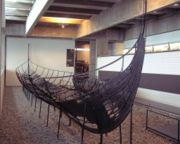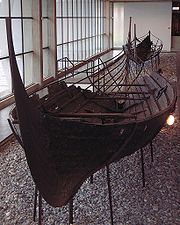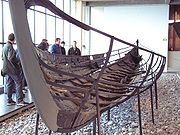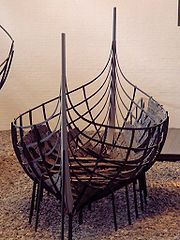
Skuldelev ships
Encyclopedia
The Skuldelev ships is a term used for 5 Viking ship
s recovered from Peberrenden by Skuldelev, c. 20 km north of Roskilde
in Denmark
. In 1962, the remains of the ships were excavated over 4 months . The recovered pieces constitute 5 types of ships and have been dated to the 11th century. The Skuldelev ships provide a good source of information about the shipbuilding traditions of the late Viking period.
Information on "Skuldelev 4" is omitted, as the discovery of a fourth ship was found to be a part of Skuldelev 2.
The ships are today exhibited at the Viking Ship Museum in Roskilde
.
type. It is 16 m long and 4.8 m wide and would have had a crew of 6 to 8. The ship, which is built from pine
and oak
, was constructed in western Sweden, and has seen repairs in eastern Denmark.
 Skuldelev 2 is an oak-built, sea-going warship. It is a longship
Skuldelev 2 is an oak-built, sea-going warship. It is a longship
, possibly of the skeid type. It is approximately 30 m long and 3.8 m wide, and would have had a crew of 70-80. Dendrochronology
showed that the ship was built in the Dublin area around 1042. The shape of the ship would have allowed for great speed, up to 15 knots (29 km/h) with a rowing crew of 60 and more while under sail. It is one of the longest Viking-ship ever found.
A reconstruction of this ship: The Sea Stallion from Glendalough (in Danish: Havhingsten) has been built by the Viking Ship Museum in Roskilde and sailed to Dublin during the summer of 2007 (arriving on 14 August). The ship was on exhibit in Dublin until the summer of 2008 at which time it was sailed back to Roskilde (arrived on August 9).
 The Skuldelev 3 is a 14 m long and 3.3 m wide cargo ship, possibly of the byrding type. It is made from oak, and was constructed somewhere in Denmark. It would have been well-suited to shorter journeys in Danish waters and the Baltic Sea
The Skuldelev 3 is a 14 m long and 3.3 m wide cargo ship, possibly of the byrding type. It is made from oak, and was constructed somewhere in Denmark. It would have been well-suited to shorter journeys in Danish waters and the Baltic Sea
, it would have held a crew of 5-6 and could reach a top-speed of 8.5 knots (17 km/h) under sail.
 Skuldelev 5 is a small warship of the snekkja type. It is 17.3 m long and 2.5 m wide and would have had a crew of about 30. It is made from oak, pine and ash
Skuldelev 5 is a small warship of the snekkja type. It is 17.3 m long and 2.5 m wide and would have had a crew of about 30. It is made from oak, pine and ash
, and was built in the Roskilde area. The ship was purpose-built for sailing in Danish waters and the Baltic Sea, and the top speed was calculated to have been about 6 knots (12 km/h).
However, the first-ever replica of this ship which was (Sebbe Als
of Augustenborg
, Denmark) showed these calculations to be wrong. 'Sebbe' is able to reach a speed of 5 knots (10 km/h) on oars alone, and under sail 'Sebbe' reaches a speed of 12 knots (24 km/h).
 Skuldelev 6 is a 11.2 m long and 2.5 m wide cargo and fishing-vessel of the ferja type. It was built in Sognefjorden in western Norway
Skuldelev 6 is a 11.2 m long and 2.5 m wide cargo and fishing-vessel of the ferja type. It was built in Sognefjorden in western Norway
, mainly from pine
. It would have had a crew of 12-14.
Viking ship
Viking ships were vessels used during the Viking Age in Northern Europe. Scandinavian tradition of shipbuilding during the Viking Age was characterized by slender and flexible boats, with symmetrical ends with true keel. They were clinker built, which is the overlapping of planks riveted together...
s recovered from Peberrenden by Skuldelev, c. 20 km north of Roskilde
Roskilde
Roskilde is the main city in Roskilde Municipality, Denmark on the island of Zealand. It is an ancient city, dating from the Viking Age and is a member of the Most Ancient European Towns Network....
in Denmark
Denmark
Denmark is a Scandinavian country in Northern Europe. The countries of Denmark and Greenland, as well as the Faroe Islands, constitute the Kingdom of Denmark . It is the southernmost of the Nordic countries, southwest of Sweden and south of Norway, and bordered to the south by Germany. Denmark...
. In 1962, the remains of the ships were excavated over 4 months . The recovered pieces constitute 5 types of ships and have been dated to the 11th century. The Skuldelev ships provide a good source of information about the shipbuilding traditions of the late Viking period.
Information on "Skuldelev 4" is omitted, as the discovery of a fourth ship was found to be a part of Skuldelev 2.
The ships are today exhibited at the Viking Ship Museum in Roskilde
Viking Ship Museum in Roskilde
The Viking Ship Museum in Roskilde is the Danish national museum for ships, seafaring and boatbuilding in the prehistoric and medieval period....
.
Skuldelev 1
Skuldelev 1 is a sturdy sea-going cargo-vessel, possibly of the knarrKnarr
The Knarr is a Bermuda rigged, long keeled, sailing yacht designed in 1943 by Norwegian Erling L. Kristofersen. Knarrer were traditionally built in wood, with the hull upside down on a fixed frame, then attaching the iron keel after the hull was completed. The hull planks were manufactured with...
type. It is 16 m long and 4.8 m wide and would have had a crew of 6 to 8. The ship, which is built from pine
Pine
Pines are trees in the genus Pinus ,in the family Pinaceae. They make up the monotypic subfamily Pinoideae. There are about 115 species of pine, although different authorities accept between 105 and 125 species.-Etymology:...
and oak
Oak
An oak is a tree or shrub in the genus Quercus , of which about 600 species exist. "Oak" may also appear in the names of species in related genera, notably Lithocarpus...
, was constructed in western Sweden, and has seen repairs in eastern Denmark.
Skuldelev 2

Longship
Longships were sea vessels made and used by the Vikings from the Nordic countries for trade, commerce, exploration, and warfare during the Viking Age. The longship’s design evolved over many years, beginning in the Stone Age with the invention of the umiak and continuing up to the 9th century with...
, possibly of the skeid type. It is approximately 30 m long and 3.8 m wide, and would have had a crew of 70-80. Dendrochronology
Dendrochronology
Dendrochronology or tree-ring dating is the scientific method of dating based on the analysis of patterns of tree-rings. Dendrochronology can date the time at which tree rings were formed, in many types of wood, to the exact calendar year...
showed that the ship was built in the Dublin area around 1042. The shape of the ship would have allowed for great speed, up to 15 knots (29 km/h) with a rowing crew of 60 and more while under sail. It is one of the longest Viking-ship ever found.
A reconstruction of this ship: The Sea Stallion from Glendalough (in Danish: Havhingsten) has been built by the Viking Ship Museum in Roskilde and sailed to Dublin during the summer of 2007 (arriving on 14 August). The ship was on exhibit in Dublin until the summer of 2008 at which time it was sailed back to Roskilde (arrived on August 9).
Skuldelev 3

Baltic Sea
The Baltic Sea is a brackish mediterranean sea located in Northern Europe, from 53°N to 66°N latitude and from 20°E to 26°E longitude. It is bounded by the Scandinavian Peninsula, the mainland of Europe, and the Danish islands. It drains into the Kattegat by way of the Øresund, the Great Belt and...
, it would have held a crew of 5-6 and could reach a top-speed of 8.5 knots (17 km/h) under sail.
Skuldelev 4
The Skuldelev 2 was originally thought to be two different ships, named Skuldelev 2 and 4. During the excavation it was discovered that they were in fact one long ship, hence the name Skuldelev 4 was stricken.Skuldelev 5

Ash tree
Fraxinus is a genus flowering plants in the olive and lilac family, Oleaceae. It contains 45-65 species of usually medium to large trees, mostly deciduous though a few subtropical species are evergreen. The tree's common English name, ash, goes back to the Old English æsc, while the generic name...
, and was built in the Roskilde area. The ship was purpose-built for sailing in Danish waters and the Baltic Sea, and the top speed was calculated to have been about 6 knots (12 km/h).
However, the first-ever replica of this ship which was (Sebbe Als
Sebbe Als
Sebbe Als is a replica of a Viking ship, Skuldelev wreck no. 5. She is the oldest sailing 'fiver' in Denmark.-Construction:A sailing trip with the Imme Gram and the then newly found Skuldelev wrecks became the inspiration for the creation of Sebbe Als.She was built by a group of local volunteers, a...
of Augustenborg
Augustenborg
Augustenborg is a town with a population of 3,279 on Als Island in Sønderborg Municipality, Region of Southern Denmark in Denmark. The town lies at the head of Als Fjord. To the east is the Little Belt...
, Denmark) showed these calculations to be wrong. 'Sebbe' is able to reach a speed of 5 knots (10 km/h) on oars alone, and under sail 'Sebbe' reaches a speed of 12 knots (24 km/h).
Skuldelev 6

Norway
Norway , officially the Kingdom of Norway, is a Nordic unitary constitutional monarchy whose territory comprises the western portion of the Scandinavian Peninsula, Jan Mayen, and the Arctic archipelago of Svalbard and Bouvet Island. Norway has a total area of and a population of about 4.9 million...
, mainly from pine
Pine
Pines are trees in the genus Pinus ,in the family Pinaceae. They make up the monotypic subfamily Pinoideae. There are about 115 species of pine, although different authorities accept between 105 and 125 species.-Etymology:...
. It would have had a crew of 12-14.

